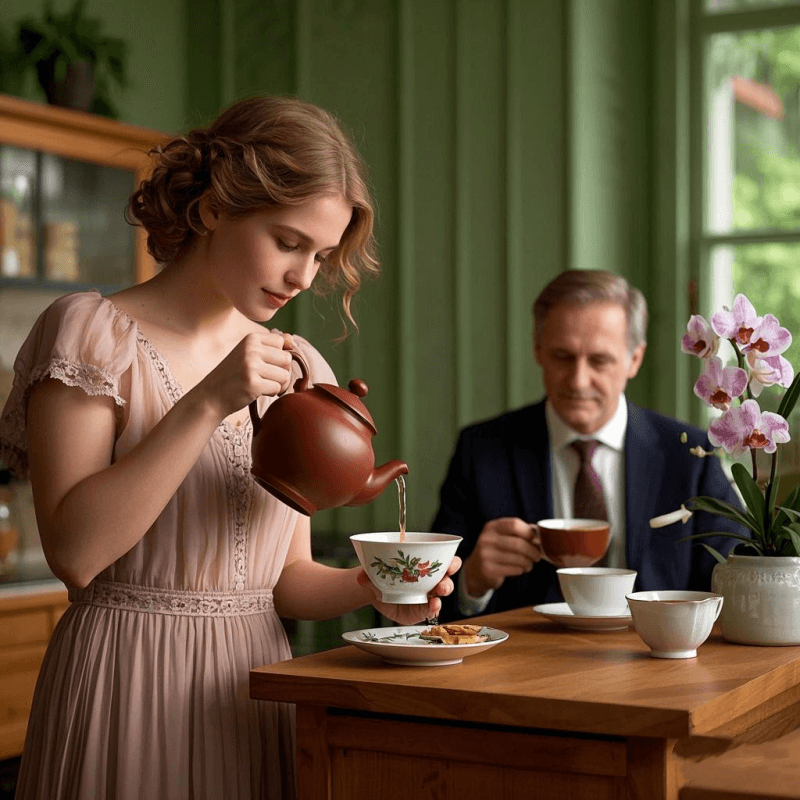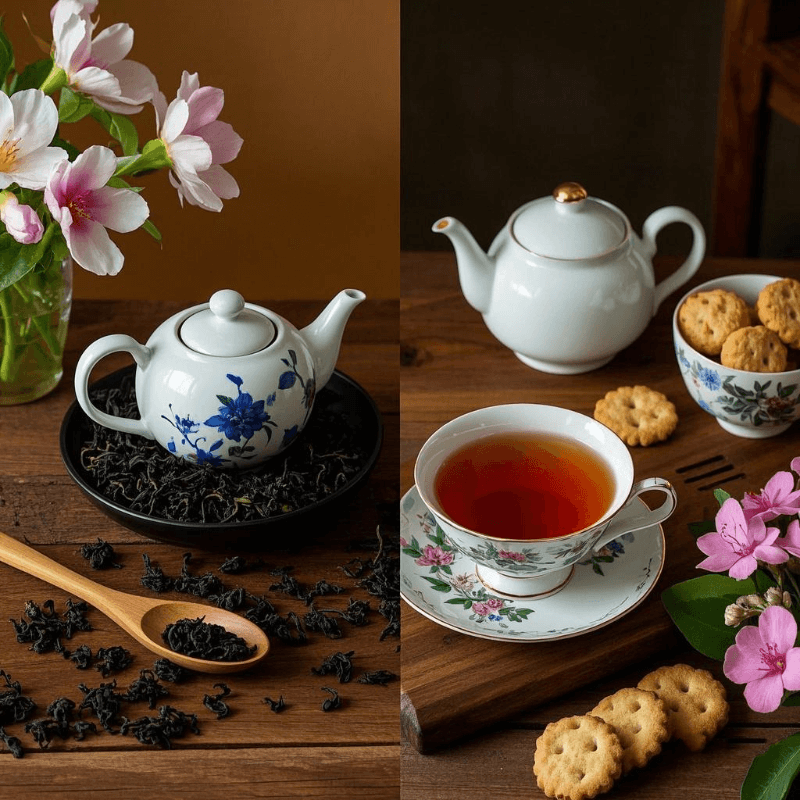
1. Introduction: Why the Oolong vs Black Tea Debate Matters
The choice between oolong and black tea isn’t just a matter of personal preference—it reflects a deep dive into the diverse world of tea. With consumers becoming more health – conscious and flavor – seeking, understanding the oolong vs black tea differences can transform your daily tea ritual. A recent survey by the Tea Association of the USA revealed that 68% of tea drinkers regularly switch between tea types, highlighting the importance of knowing what each offers. Whether you’re a seasoned tea connoisseur or new to the world of tea, exploring the oolong vs black tea debate unlocks insights into taste, nutrition, and cultural significance.
Take the case of Sarah, a marketing professional in New York. She used to start her day with a cup of black tea for its bold flavor and caffeine kick. However, after learning about the nuanced taste profiles of oolong tea, she decided to explore. “I was blown away by the complexity of oolong,” Sarah shared. “One variety tasted like fresh flowers, while another had this deep, roasted aroma. It made me realize how much I was missing out on.” This anecdote underscores how understanding the differences between oolong vs black tea can open up new tea – drinking horizons.
2. What Is Oolong Tea and What Is Black Tea? Key Definitions
To understand the oolong vs black tea comparison, it’s crucial to start with the basics:
Oolong Tea
oolong tea is a semi – fermented tea, falling between green tea (lightly oxidized) and black tea (fully oxidized). Its oxidation levels range from 8% to 85%, resulting in a wide flavor spectrum. Grown primarily in China and Taiwan, oolong tea undergoes a meticulous process that includes withering, rolling, oxidation, and firing. Whole – leaf oolong tea varieties are prized for their ability to be steeped multiple times, revealing new flavors with each infusion.
For instance, in the high mountains of Taiwan, tea pickers carefully hand – select leaves for premium oolong tea. These leaves are then spread out to wither under the sun, a step that begins the oxidation process. After that, skilled tea artisans roll the leaves by hand, a labor – intensive method that helps release the tea’s essential oils. This attention to detail is what gives oolong tea its unique character.
Black Tea
Black tea is fully oxidized, giving it a robust flavor and dark color. Originating in China but now produced globally, black tea leaves are withered, rolled, oxidized, and fired. Popular black tea types include Assam (India), Darjeeling (India), and Ceylon (Sri Lanka). Unlike oolong tea, black tea is often enjoyed with milk and sugar, though purists appreciate its bold taste on its own.
In the Assam region of India, vast tea estates stretch as far as the eye can see. Here, the black tea production process is highly mechanized, allowing for large – scale production. The leaves are harvested, withered on conveyor belts, and then cut into small pieces before oxidation. This efficient process is what makes Assam black tea one of the most widely consumed black teas in the world.
3. Taste Comparison: How Oolong and Black Tea Differ in Flavor

The most noticeable difference between oolong vs black tea lies in their taste profiles:
Oolong Tea Flavors
- Lightly Oxidized Oolongs: Varieties like Taiwanese High Mountain oolong tea offer delicate floral notes, reminiscent of jasmine or orchids, with a sweet, almost fruity finish. Imagine sipping a cup of this tea on a sunny morning—it’s like having a bouquet of fresh flowers in your mug.
- Highly Oxidized Oolongs: Wuyi rock oolong tea, for example, presents earthy, mineral – rich flavors with hints of roasted chestnut or caramel. These oolongs are perfect for those who enjoy a more intense and complex taste, similar to sipping a fine aged whiskey.
Black Tea Flavors
- Assam Black Tea: Known for its malty, full – bodied flavor, making it a classic choice for breakfast blends. When paired with a hearty English breakfast of eggs, bacon, and toast, Assam black tea provides the perfect complement.
- Darjeeling Black Tea: Often called the “Champagne of teas,” it has a delicate muscatel aroma and a lighter, more floral taste compared to Assam. This makes Darjeeling black tea an excellent option for afternoon tea parties, where it can be enjoyed with delicate pastries and sandwiches.
As tea sommelier Jane Chen notes, “Oolong tea is like a chameleon—it can be light and refreshing or bold and complex. Black tea, on the other hand, makes its presence known with its strong, assertive flavor.”
4. Caffeine and Nutrition: What Sets These Teas Apart
When it comes to nutrition and caffeine content, oolong vs black tea have distinct characteristics:
Caffeine Levels
- Oolong Tea: Generally contains moderate caffeine, ranging from 12–55mg per 8 – ounce cup, depending on the variety and brewing method. For those who are sensitive to caffeine but still want a gentle pick – me – up, oolong tea is an ideal choice.
- Black Tea: Typically has higher caffeine, with 40–70mg per 8 – ounce cup. However, factors like leaf size and brewing time also impact caffeine release. A study by [WebMD](https://www.webmd.com/diet/features/tea – caffeine – content) provides a comprehensive breakdown of tea caffeine levels. This makes black tea a go – to for those who need a stronger caffeine boost to start their day or power through an afternoon slump.
Nutritional Benefits
- Oolong Tea: Rich in polyphenols, antioxidants that may aid in weight management and heart health. A study published in the Journal of Agricultural and Food Chemistry found that oolong tea can boost metabolism. Discover the subtle beauty of oolong tea with our premium leaves and experience its potential benefits firsthand. These antioxidants can also help protect the body against oxidative stress and inflammation.
- Black Tea: Also high in polyphenols, particularly theaflavins, which may reduce cholesterol levels and improve gut health. Theaflavins work by binding to cholesterol in the digestive tract, preventing its absorption into the bloodstream.
5. Health Benefits of Oolong vs Black Tea
Both oolong tea and black tea offer impressive health advantages:
Oolong Tea Benefits
- Weight Management: The antioxidants in oolong tea may increase fat metabolism. This means that your body can break down and burn fat more efficiently, potentially leading to weight loss over time.
- Heart Health: Regular consumption of oolong tea may lower blood pressure and cholesterol levels. By relaxing the blood vessels and reducing the amount of “bad” cholesterol in the blood, oolong tea helps maintain a healthy cardiovascular system.
Black Tea Benefits
- Digestive Health: Black tea’s theaflavins can promote a healthy gut microbiome. A healthy gut microbiome is essential for proper digestion, immune function, and overall well – being.
- Cognitive Function: Caffeine combined with L – theanine in black tea may enhance focus and reduce stress. L – theanine has a calming effect on the brain, counteracting the jitters that can sometimes come with caffeine consumption.
6. Brewing Methods and Cultural Significance
The oolong vs black tea differences extend to brewing traditions and cultural roles:
Brewing Methods
- Oolong Tea: Often brewed using the gongfu method, with small amounts of tea steeped multiple times in a gaiwan or Yixing clay pot. Elevate your tea experience with authentic oolong teaware for the best results. The gongfu method allows tea drinkers to fully appreciate the changing flavors of oolong tea with each steep.
- Black Tea: Commonly brewed in a teapot with boiling water, and can be enjoyed with milk and sugar, especially in Western cultures. In the United Kingdom, the ritual of making a proper cup of black tea involves heating the teapot, adding loose – leaf tea, and pouring in freshly boiled water. The tea is then left to steep for a few minutes before being served with milk and sugar to taste.
Cultural Significance
- Oolong Tea: Holds a central place in Chinese and Taiwanese tea ceremonies, symbolizing harmony and mindfulness. These ceremonies are often slow – paced and highly ritualized, with each step carefully choreographed to create a sense of tranquility and connection.
- Black Tea: A staple in British culture, where afternoon tea with black tea is a cherished tradition. In India, masala chai, a spiced black tea, is a daily ritual. The act of sharing a cup of masala chai with friends and family is an important part of Indian social life.
7. Conclusion: Which Tea Is Right for You?
The choice between oolong vs black tea ultimately depends on your taste preferences, health goals, and lifestyle. If you prefer complex, evolving flavors and a lower caffeine option, oolong tea might be your match. For those who enjoy bold, robust tastes and need an energy boost, black tea is ideal.
Ready to explore? Browse our oolong tea collection for every taste preference and find your perfect cup. And when you’re ready to savor the full flavor, savor the taste of oolong tea with traditional brewing tools designed to enhance its unique qualities. Whether you choose oolong tea or black tea, each sip is an opportunity to experience the rich tapestry of tea culture.
